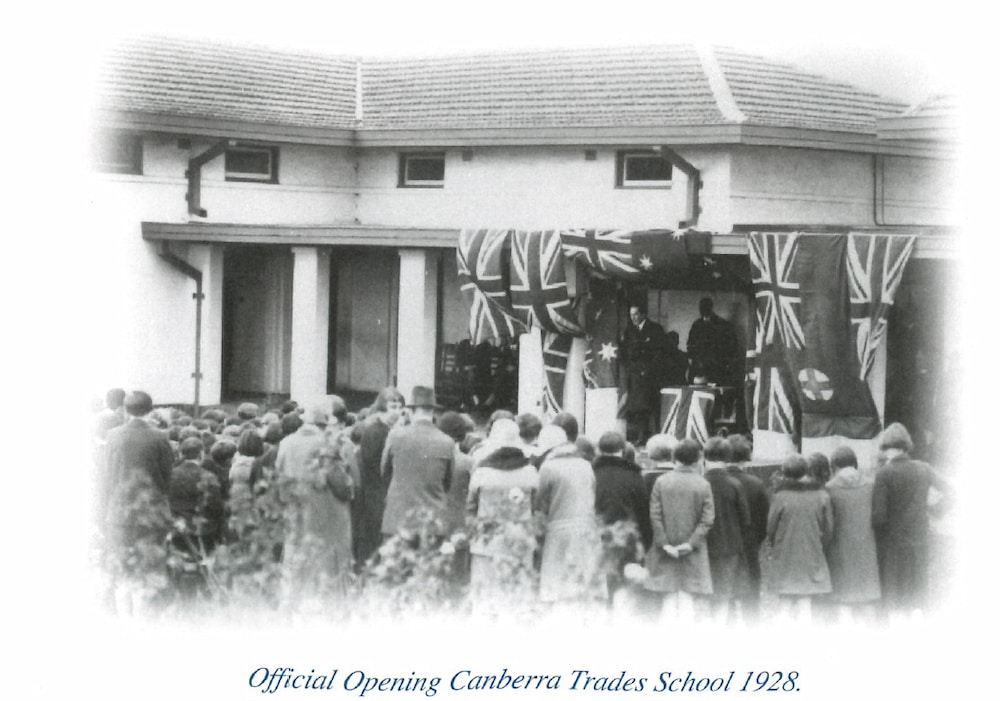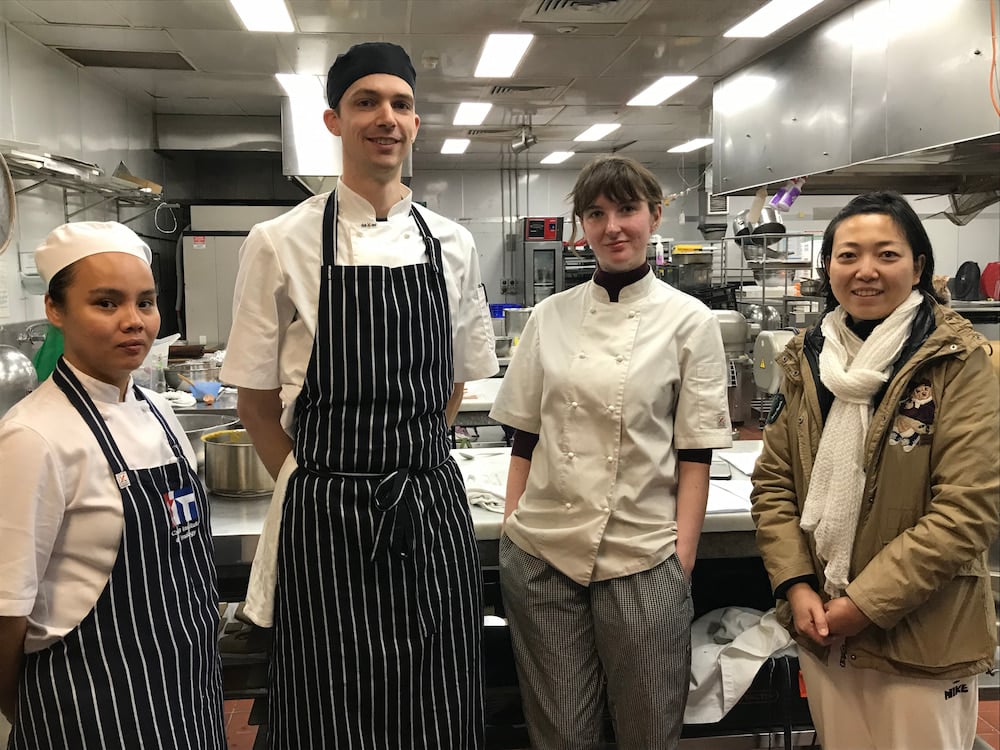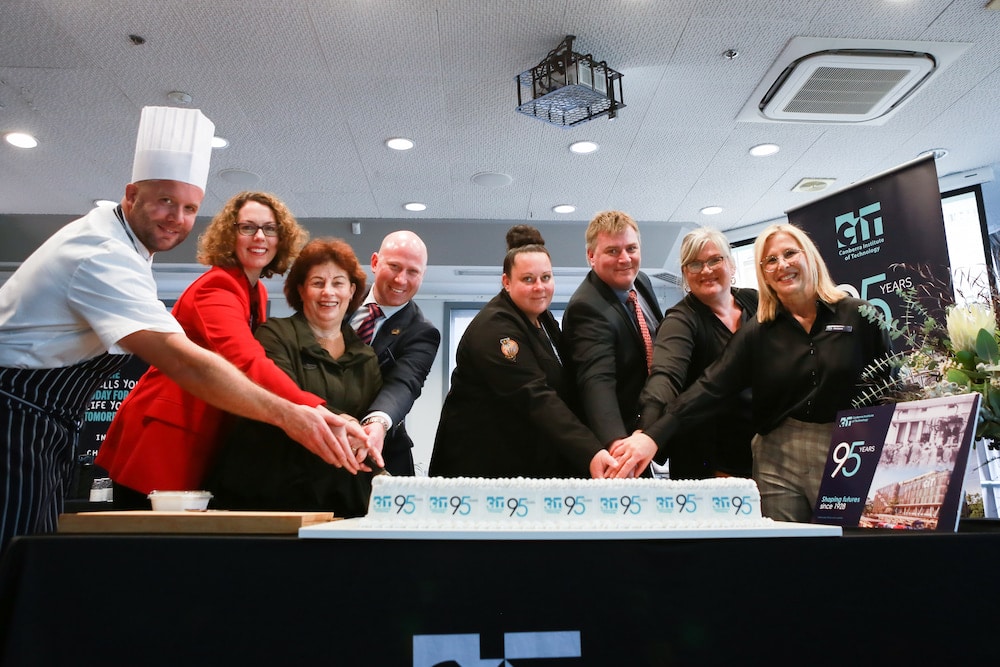James Bond studied mechanical trades at the Canberra Institute of Technology. Or at least one of the actors who portrayed him, Queanbeyan-born George Lazenby, went to the CIT in the 1950s, a decade before On Her Majesty’s Secret Service.
But there is little secret about the educational service the CIT – which turned 95 this week – has provided to the people of Canberra for nearly a century.
“CIT has such a central place in our community and in our economy,” Alicia Payne MP said. “There’s no way our city could function without the tens of thousands of graduates with the essential skills in the essential professions that they learn here.”
Ninety-five years ago this Tuesday, on 6 June 1928, prime minister Stanley Bruce opened the Canberra Trades School, as the CIT was known then.

Using facilities at Telopea Park School, it taught technical trades (fitting and machining, plumbing and sheet metal work, motor maintenance, engineering and trade drawing, carpentry and joinery), commercial classes, and domestic science (dressmaking, needlework, and cookery). Women could not enrol in technical trades, nor male students in domestic science.
In 1928, 80 students attended the technical trades and commercial classes, while 60 women, who wanted to become secretaries in the Public Service, attended evening classes in typing, shorthand, business principles, English, and mathematics.
That, interim CEO Christine Robertson said, was “a far cry from the approximately 20,000 students who now train with CIT every year”.
Today, in fact, the CIT is the biggest educational institution in the ACT, spread across five campuses (Bruce, Fyshwick, Gungahlin, Reid, Tuggeranong). A new Woden campus will open in 2025.
- Woden CIT campus DA open for comment (10 January)
The key to the CIT’s success, Ms Robertson believes, is its relevance: the courses prepare students for work – and for life.
“You can easily make that connection between the training that we deliver, the programs that students enrol in, and the way they understand where they can take that learning and what they can do with it.”
The CIT also adapts its programs to new skills and technologies, Ms Robertson said. “We look at what the ACT community and at what ACT industry need.”
Whether that be cybersecurity (ranging from entry level qualifications to pathways and degrees); running Canberra’s first training program for electric and hydrogen vehicle maintenance (aligning with ACT Government priorities); or training first responders in how to deal with electric vehicle accidents – “a whole new skillset that the industry needs to ensure safety and ongoing viability”.
- CIT opens Canberra’s first electric and hydrogen vehicle workshop (10 May 2022)
- Bus mechanics ‘all aboard!’ for reskilling to electric (8 December 2021)
“Our staff are always learning,” Ms Robertson said. “When our curriculum changes, when the skills for work change, when our industry says to us, we need this type of graduate with these skills, our staff will adapt.”
The CIT has had some recent troubles. Last year, the revelation that the institution paid $8.5 million contracts to consultant Patrick Hollingworth led to an investigation by the ACT Integrity Commission.
- CIT’s $9 million contracts a concern for taxpayers (7 June 2022)
But the TAFE can also point to awards for teaching excellence – last year, automotive trainer Richard Lindsay received a national award as VET Teacher / Trainer of the Year, for instance – while staff and students speak highly of the CIT.
- CIT teacher named Australia’s top VET trainer of the year (30 November 2022)
“It’s the best job I’ve ever had!” culinary teacher David Damour says. “It’s amazing because it’s such a big organisation, but you still get to meet people and to help each other. There is a really good team culture.”
The Frenchman has worked at the CIT for almost six years now, teaching students how to bake bread, cakes, and pastries. Because his students are with him for up to three years, he develops good friendships with them.
“I just love being here,” Jeremy Ferrer, who has studied commercial cookery and patisserie at CIT for 18 months, says. “It feels like family. The teachers are very helpful; they are always there when you need help.” (CIT is also where Jeremy, who comes from the Philippines, learnt English.)

Donna Zhao agrees. The teachers, she said, guided her, and helped her find her passion and achieve her goals. Last week, she won an award for a gluten-free pie in Australia’s Best Pies and Pasties Competition. She works as a pastry chef, and wanted to use the knowledge she acquired at CIT to give back, cooking for people with special dietary requirements.
Mr Dafour says training students is one of his most rewarding memories. Two years ago, Rachel Crawford came fourth in the world in the WorldSkills championships for vocational students; her croissants impressed judges in Switzerland.
Another student could follow in her footsteps. Caci Mitchell won the regional competition last year, and will contend against the rest of Australia in a three-day competition in Melbourne in August. If she wins, she will go to France. She works at the Nimmitabel Bakery, two hours away from the CIT, and comes to CIT twice a week to practise for the competition. But eight hours of driving are worth it, she thinks.
“CIT’s help is invaluable; they’re really building my confidence so I can handle the competition,” she said.
“CIT gives me connections to other people in the industry; I can specialise in a lot of different aspects of baking; it gives me an opportunity to make stuff that we don’t make at the workplace; and I get a wide array of skills.”
Matthew Mason, an apprentice who has been at CIT for three months, also enjoys the industry connections.
“It’s a really good learning environment; you get the chance to interact with other students who are in other areas of the profession. You don’t often get a chance to interact with people from other restaurants or other areas of the industry. So, this is a fantastic spot to do that and network across the industry.”
“The good thing about vocational education and training,” Ms Robertson says, “is that students can move in and out of the organisation; they can do an apprenticeship program or a Certificate III; they can enrol in a diploma; but there’s movement in and out across the organisation, and then some of our graduates become staff members down the track.
“Being a vocational education and training educator means that not only do you teach, but you also yourself maintain your discipline currency. So, chefs teaching culinary art skills will go back into industry from time to time to keep their skills current and fresh, keep networks going, and remain engaged with the industry. Students go through their learning pathway, but also go to work; maybe they’ll come back and reinvigorate and regenerate. So, it’s a constant cycle of renewal and learning, and of providing the skills that we need.”
More students are able to go to the CIT this year, thanks to a Fee-Free TAFE program funded by the Federal and ACT Governments to address skills shortages. As of last month, 1,000 people had enrolled in the 2,500 training places available. 61.5 per cent of those places went to women, more than 200 to people with disability, and over half to people who speak a language other than English at home, Ms Payne noted.
The recent federal budget allocated a further $400 million for 300,000 training places nationally.
The federal government has also pledged $10 million to a youth foyer at the new Woden campus.
- Thousands of fee-free places at Canberra’s CIT (24 January)
- More fee-free courses at Canberra’s CIT (24 May)
- Labor commits to youth foyer for vulnerable students (12 May 2022)
“We’ve got lots of plans for the future, but we aspire to continue to be the quality provider of tertiary education in the ACT,” Ms Robertson said. Here’s to the next 95 years.



